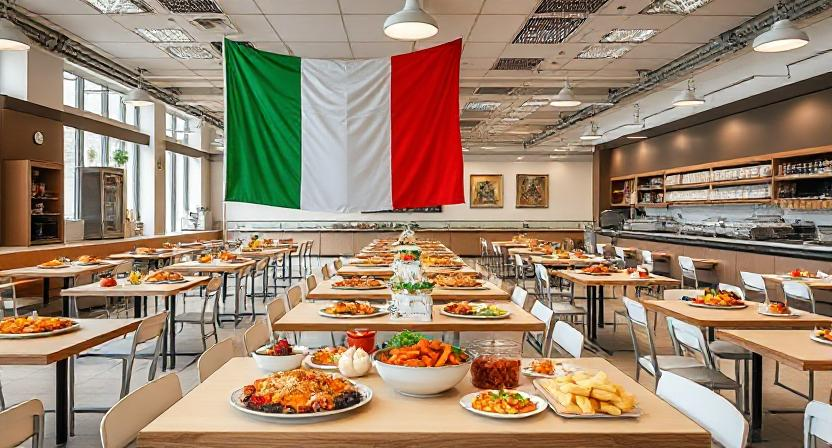

The Italian School Lunch: A Model of Healthy Eating and Sustainability


Arya Soleil
In a world where school lunches are often associated with processed foods, low-cost ingredients, and fast-food influences, Italy stands as an exemplary model of how school meals can be both nutritious and delicious. With 98% of the ingredients locally grown and produced, this approach to school nutrition ensures students receive high-quality meals that promote health, sustainability, and a deep-rooted appreciation for food culture. Unlike in many other parts of the world, Italian schools do not award food contracts to the lowest bidder associated with fast food or soda companies. Instead, the priority is to serve fresh, locally sourced, and homemade meals that contribute to both student well-being and the local economy.
A Look at the Italian School Lunch Plate
A typical school meal in Italy reflects the country’s philosophy of balanced nutrition. It may consist of fresh fruits, a Mediterranean-style salad, whole grain bread, herbed pasta, and a well-prepared portion of fish or meat served with leafy greens. Each component of these meals is carefully selected to provide students with essential nutrients, fiber, and healthy fats. The inclusion of fresh, whole foods rather than heavily processed options ensures that students consume meals that contribute to their long-term health and well-being.
The Importance of Local and Seasonal Ingredients
One of the key aspects of the Italian school lunch system is its commitment to using local and seasonal ingredients. This practice not only supports local farmers and producers but also guarantees that the food served is fresh, flavorful, and nutrient-dense. Unlike mass-produced cafeteria meals that rely on frozen and pre-packaged foods, Italian school lunches embrace the farm-to-table approach. This commitment to fresh ingredients means that students are exposed to a variety of vegetables, fruits, and proteins that change with the seasons, fostering an appreciation for diverse flavors and natural nutrition.
A Commitment to Homemade Meals Over Processed Foods
Many school cafeterias around the world rely heavily on processed and pre-packaged foods due to budget constraints and convenience. In contrast, Italian schools prioritize homemade meals prepared by professional chefs or kitchen staff who ensure that each dish is crafted with care. This approach eliminates the need for artificial preservatives, excess sodium, and unhealthy additives commonly found in processed foods. The result is a meal that is not only healthier but also more enjoyable and satisfying for students.
Nutritional Balance in Italian School Lunches
The Italian school lunch follows a well-balanced nutritional framework that aligns with Mediterranean dietary principles. Each meal is designed to include a balance of carbohydrates, proteins, healthy fats, and fiber. Pasta provides a source of complex carbohydrates, while fish or lean meats offer protein and omega-3 fatty acids essential for brain development. The inclusion of fresh vegetables and fruits ensures students receive adequate vitamins and minerals. Whole grain bread further contributes to fiber intake, promoting healthy digestion. This balanced composition allows students to stay energized throughout the day, improving focus and cognitive function in the classroom.
Encouraging Healthy Eating Habits From an Early Age
One of the most significant benefits of Italy’s school lunch system is its role in shaping children’s lifelong eating habits. By providing meals made from fresh, high-quality ingredients, schools play a crucial role in teaching students to appreciate real food and make healthier dietary choices. In contrast to highly processed meals that are often laden with sugar, unhealthy fats, and artificial ingredients, Italian school lunches reinforce the importance of wholesome eating. Students are more likely to develop positive associations with healthy foods, reducing their inclination toward junk food and fast-food diets later in life.
A Cultural Approach to Mealtime
In Italy, food is deeply embedded in the culture, and mealtime is considered a cherished experience rather than a rushed necessity. School lunches reflect this philosophy by encouraging students to take the time to enjoy their meals in a communal setting. Instead of hurriedly consuming their food in a noisy cafeteria, students are encouraged to sit down, engage in conversation, and savor each bite. This mindful eating approach fosters a healthier relationship with food and reduces the risk of overeating, a habit often associated with rushed and distracted eating.
The Contrast Between Italian and American School Lunches
A comparison between Italian school lunches and those served in many American schools highlights stark differences in quality, nutrition, and food philosophy. In the United States, school lunches are often dictated by cost-saving measures that prioritize affordability over nutrition. As a result, students are frequently served processed foods such as frozen pizza, chicken nuggets, and sugary beverages. Many school districts rely on contracts with large food corporations, leading to meals that are high in unhealthy fats, sodium, and refined sugars. The Italian approach, on the other hand, emphasizes food quality over cost-cutting, ensuring that students receive meals that are both nutritious and culturally enriching.
The Role of Government and Policy in School Nutrition
The Italian school lunch system is supported by government policies that prioritize the health and well-being of students. Local governments work in collaboration with nutritionists, farmers, and school administrators to design meal programs that meet strict health and sustainability standards. Unlike in other countries where school meal programs may be influenced by corporate interests, Italy’s school lunch policies focus on fostering a healthy food culture that aligns with traditional dietary values. By maintaining high standards for school nutrition, Italy sets a precedent for other nations to follow.
The Economic and Environmental Benefits of Locally Sourced School Meals
Beyond the health benefits, the Italian school lunch system also contributes to the local economy and promotes environmental sustainability. By sourcing ingredients from local farms, schools help sustain small-scale agriculture and reduce reliance on industrial food production. This practice not only ensures that farmers receive fair compensation but also reduces the carbon footprint associated with transporting food over long distances. The emphasis on fresh, whole foods also minimizes food waste and packaging waste, making the system more environmentally friendly compared to school meal programs that rely on packaged and processed foods.
Lessons Other Countries Can Learn from Italy
Italy’s approach to school lunches serves as an inspiring model for other nations looking to improve their school meal programs. While financial constraints and systemic challenges may prevent immediate large-scale changes, there are several lessons that can be implemented globally. Schools can begin by prioritizing fresh and locally sourced ingredients, reducing the use of processed foods, and incorporating nutrition education into the curriculum. By fostering an appreciation for real food and advocating for policy changes that support healthier school meals, other countries can work toward a more sustainable and nutritious future for students.
Final Thoughts
The Italian school lunch system proves that it is possible to provide students with meals that are both healthy and enjoyable. By prioritizing fresh, local ingredients and emphasizing homemade meals over processed alternatives, Italy ensures that its students receive the nourishment they need to thrive. This approach not only benefits individual health but also contributes to a more sustainable and environmentally friendly food system. As other countries seek to reform their school meal programs, they can look to Italy as a shining example of how to cultivate a healthier and more food-conscious generation.
Recommended Reads

- March 22, 2025
Anti-Inflammatory Breakfasts: Easy Recipes to Start Your Day Right
Home News Healthy Habits & Lifestyle Health Conditions &...


- March 22, 2025
Questioning the FDA: A Deeper Look at the Food and Drug Administration’s Role
Home News Healthy Habits & Lifestyle Health Conditions &...


- March 22, 2025
Make ‘Raw Milk’ Just ‘Milk’ Again: A Closer Look at the Raw Milk Debate
Home News Healthy Habits & Lifestyle Health Conditions &...


- March 22, 2025
The Power of Sweet Potatoes: A Superfood for Eyes, Skin, and Beyond
Home News Healthy Habits & Lifestyle Health Conditions &...


- March 22, 2025
Sugar-Free: A Code Word for “We’ve Replaced It with Something Worse for You”
Home News Healthy Habits & Lifestyle Health Conditions &...


- March 22, 2025
The Evolution of Food: How Modern Diets Are Fueling Chronic Disease
Home News Healthy Habits & Lifestyle Health Conditions &...

The Italian School Lunch: A Model of Healthy Eating and Sustainability

In a world where school lunches are often associated with processed foods, low-cost ingredients, and fast-food influences, Italy stands as an exemplary model of how school meals can be both nutritious and delicious. With 98% of the ingredients locally grown and produced, this approach to school nutrition ensures students receive high-quality meals that promote health, sustainability, and a deep-rooted appreciation for food culture. Unlike in many other parts of the world, Italian schools do not award food contracts to the lowest bidder associated with fast food or soda companies. Instead, the priority is to serve fresh, locally sourced, and homemade meals that contribute to both student well-being and the local economy.
A Look at the Italian School Lunch Plate
A typical school meal in Italy reflects the country’s philosophy of balanced nutrition. It may consist of fresh fruits, a Mediterranean-style salad, whole grain bread, herbed pasta, and a well-prepared portion of fish or meat served with leafy greens. Each component of these meals is carefully selected to provide students with essential nutrients, fiber, and healthy fats. The inclusion of fresh, whole foods rather than heavily processed options ensures that students consume meals that contribute to their long-term health and well-being.
The Importance of Local and Seasonal Ingredients
One of the key aspects of the Italian school lunch system is its commitment to using local and seasonal ingredients. This practice not only supports local farmers and producers but also guarantees that the food served is fresh, flavorful, and nutrient-dense. Unlike mass-produced cafeteria meals that rely on frozen and pre-packaged foods, Italian school lunches embrace the farm-to-table approach. This commitment to fresh ingredients means that students are exposed to a variety of vegetables, fruits, and proteins that change with the seasons, fostering an appreciation for diverse flavors and natural nutrition.
A Commitment to Homemade Meals Over Processed Foods
Many school cafeterias around the world rely heavily on processed and pre-packaged foods due to budget constraints and convenience. In contrast, Italian schools prioritize homemade meals prepared by professional chefs or kitchen staff who ensure that each dish is crafted with care. This approach eliminates the need for artificial preservatives, excess sodium, and unhealthy additives commonly found in processed foods. The result is a meal that is not only healthier but also more enjoyable and satisfying for students.
Nutritional Balance in Italian School Lunches
The Italian school lunch follows a well-balanced nutritional framework that aligns with Mediterranean dietary principles. Each meal is designed to include a balance of carbohydrates, proteins, healthy fats, and fiber. Pasta provides a source of complex carbohydrates, while fish or lean meats offer protein and omega-3 fatty acids essential for brain development. The inclusion of fresh vegetables and fruits ensures students receive adequate vitamins and minerals. Whole grain bread further contributes to fiber intake, promoting healthy digestion. This balanced composition allows students to stay energized throughout the day, improving focus and cognitive function in the classroom.
Encouraging Healthy Eating Habits From an Early Age
One of the most significant benefits of Italy’s school lunch system is its role in shaping children’s lifelong eating habits. By providing meals made from fresh, high-quality ingredients, schools play a crucial role in teaching students to appreciate real food and make healthier dietary choices. In contrast to highly processed meals that are often laden with sugar, unhealthy fats, and artificial ingredients, Italian school lunches reinforce the importance of wholesome eating. Students are more likely to develop positive associations with healthy foods, reducing their inclination toward junk food and fast-food diets later in life.
A Cultural Approach to Mealtime
In Italy, food is deeply embedded in the culture, and mealtime is considered a cherished experience rather than a rushed necessity. School lunches reflect this philosophy by encouraging students to take the time to enjoy their meals in a communal setting. Instead of hurriedly consuming their food in a noisy cafeteria, students are encouraged to sit down, engage in conversation, and savor each bite. This mindful eating approach fosters a healthier relationship with food and reduces the risk of overeating, a habit often associated with rushed and distracted eating.
The Contrast Between Italian and American School Lunches
A comparison between Italian school lunches and those served in many American schools highlights stark differences in quality, nutrition, and food philosophy. In the United States, school lunches are often dictated by cost-saving measures that prioritize affordability over nutrition. As a result, students are frequently served processed foods such as frozen pizza, chicken nuggets, and sugary beverages. Many school districts rely on contracts with large food corporations, leading to meals that are high in unhealthy fats, sodium, and refined sugars. The Italian approach, on the other hand, emphasizes food quality over cost-cutting, ensuring that students receive meals that are both nutritious and culturally enriching.
The Role of Government and Policy in School Nutrition
The Italian school lunch system is supported by government policies that prioritize the health and well-being of students. Local governments work in collaboration with nutritionists, farmers, and school administrators to design meal programs that meet strict health and sustainability standards. Unlike in other countries where school meal programs may be influenced by corporate interests, Italy’s school lunch policies focus on fostering a healthy food culture that aligns with traditional dietary values. By maintaining high standards for school nutrition, Italy sets a precedent for other nations to follow.
The Economic and Environmental Benefits of Locally Sourced School Meals
Beyond the health benefits, the Italian school lunch system also contributes to the local economy and promotes environmental sustainability. By sourcing ingredients from local farms, schools help sustain small-scale agriculture and reduce reliance on industrial food production. This practice not only ensures that farmers receive fair compensation but also reduces the carbon footprint associated with transporting food over long distances. The emphasis on fresh, whole foods also minimizes food waste and packaging waste, making the system more environmentally friendly compared to school meal programs that rely on packaged and processed foods.
Lessons Other Countries Can Learn from Italy
Italy’s approach to school lunches serves as an inspiring model for other nations looking to improve their school meal programs. While financial constraints and systemic challenges may prevent immediate large-scale changes, there are several lessons that can be implemented globally. Schools can begin by prioritizing fresh and locally sourced ingredients, reducing the use of processed foods, and incorporating nutrition education into the curriculum. By fostering an appreciation for real food and advocating for policy changes that support healthier school meals, other countries can work toward a more sustainable and nutritious future for students.
Final Thoughts
The Italian school lunch system proves that it is possible to provide students with meals that are both healthy and enjoyable. By prioritizing fresh, local ingredients and emphasizing homemade meals over processed alternatives, Italy ensures that its students receive the nourishment they need to thrive. This approach not only benefits individual health but also contributes to a more sustainable and environmentally friendly food system. As other countries seek to reform their school meal programs, they can look to Italy as a shining example of how to cultivate a healthier and more food-conscious generation.
Recommended Reads

- March 22, 2025
Anti-Inflammatory Breakfasts: Easy Recipes to Start Your Day Right
Home News Healthy Habits & Lifestyle Health Conditions &...


- March 22, 2025
Questioning the FDA: A Deeper Look at the Food and Drug Administration’s Role
Home News Healthy Habits & Lifestyle Health Conditions &...


- March 22, 2025
Make ‘Raw Milk’ Just ‘Milk’ Again: A Closer Look at the Raw Milk Debate
Home News Healthy Habits & Lifestyle Health Conditions &...


- March 22, 2025
The Power of Sweet Potatoes: A Superfood for Eyes, Skin, and Beyond
Home News Healthy Habits & Lifestyle Health Conditions &...


- March 22, 2025
Sugar-Free: A Code Word for “We’ve Replaced It with Something Worse for You”
Home News Healthy Habits & Lifestyle Health Conditions &...


- March 22, 2025
The Evolution of Food: How Modern Diets Are Fueling Chronic Disease
Home News Healthy Habits & Lifestyle Health Conditions &...



